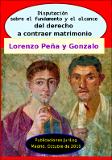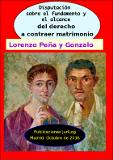Por favor, use este identificador para citar o enlazar a este item:
http://hdl.handle.net/10261/137546COMPARTIR / EXPORTAR:
 SHARE
BASE SHARE
BASE
|
|
| Visualizar otros formatos: MARC | Dublin Core | RDF | ORE | MODS | METS | DIDL | DATACITE | |

| Título: | Disputación sobre el fundamento y el alcance del derecho a contraer matrimonio |
Otros títulos: | A discussion on the foundations and the scope of the right to marry | Autor: | Peña, Lorenzo CSIC | Palabras clave: | Human rights family life Cohabitation perennial commitments repudiation marriage wedlock |
Fecha de publicación: | 2-oct-2016 | Editor: | Publicaciones Jurilog | Resumen: | This paper ensues from the debate raised by a previous article, «The right to wedded life in contemporary society», 2010, included as a chapter of the Doctoral Dissertation on Juridical Science, «Idea Iuris Logica», 2015, which was a compilation Thesis, whose concluding section was a set of 48 propositions, five of which were given over to the right to marry, viz.: (1) it is one of the most essential human rights; (2) it is partly a freedom right but also a welfare right; (3) as an associative right it implies the power not just to start a joint life but also to remain therein and not to be forcibly ousted without due reason; (4) a suitable legal implementation calls for the existence of several cohabitation contracts or covenants of different degrees of mutual commitment and duration, with the possibility of a life-long or perpetual bond for those who choose it; and (5) the current lgislation both in Spain and elsewhere is quite unsatisfactory. Those propositions aroused a heated controversy, ten main objections being levelled at my claims. They broach such issues as same-sex marriage, the clash between an undisturbed wedded life and the rights of children, the purportedly necessary anarchy presiding over any two-membered society, which would entail a permanent right to abandon the partner without cause (repudiation), the significance of marriage as against friendship or togetherness in general and the suspiciousness of perennial commitments. Now I thoroughly go into all ten objections and shore up my assertions with further reasons. Then I canvass historical experience, namely the soviet attempt at demolishing family relations in the period 1917-1935, which was doomed to fail; I consider ethnographic evidence, and last I examine the polemics brought about by the UN Human-rights Council Resolution 29/22, passed on 2015-07-02, for the protection of the family. My conclusion is that the West has now chosen the disastrous path blazed out by the Bolsheviks 90 years ago. | Descripción: | Este trabajo profundiza y desarrolla las tesis propuestas en el artículo de 2010 "El derecho a la vida conyugal en la sociedad contemporánea" (publicado en ARBOR), contestando a 10 objeciones, lo cual da lugar a incorporar materiales tomados de la historia reciente de las instituciones matrimoniales y de los hallazgos de la etnografía. | URI: | http://hdl.handle.net/10261/137546 |
| Aparece en las colecciones: | (CCHS-IFS) Artículos |
Ficheros en este ítem:
| Fichero | Descripción | Tamaño | Formato | |
|---|---|---|---|---|
| matrimonio.pdf | PDF. DINA5 | 4,59 MB | Adobe PDF |  Visualizar/Abrir |
| matrimonio_a4.pdf | PDF. DINA4 | 4,42 MB | Adobe PDF |  Visualizar/Abrir |
CORE Recommender
Page view(s)
416
checked on 13-may-2024
Download(s)
515
checked on 13-may-2024
Google ScholarTM
Check
NOTA: Los ítems de Digital.CSIC están protegidos por copyright, con todos los derechos reservados, a menos que se indique lo contrario.


